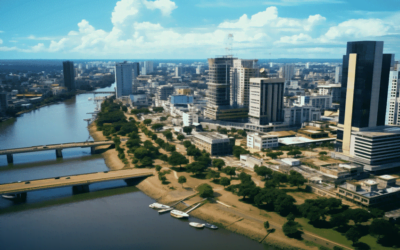Hey there, fellow drone enthusiasts! If you’re reading this, you’ve probably got some burning questions about Trinidad and Tobago’s drone laws. It can be a bit perplexing to navigate the skies with your drone, especially in a place like Trinidad and Tobago, where the rules might not be as clear as the blue Caribbean waters.
But don’t worry, I’ve been there too, and I understand the search intent. So, let’s take a journey together to uncover the ins and outs of Trinidad and Tobago’s drone regulations.
You might be wondering, “How do I know all this?” Well, I’ve delved into the realm of Trinidad and Tobago drone laws, leaving no stone unturned in my quest for answers.
I’ve scoured official documents, talked to local experts, and even had a few conversations with drone pilots who’ve soared through these vibrant skies.
The research has been enlightening, and I’m here to share my findings, helping you navigate this intricate airspace.
So, if you’re seeking solutions, look no further. In the upcoming article, we’ll unravel the mysteries of Trinidad and Tobago’s drone laws together.
I’ll provide you with the expertise, insights, and clarity you need to fly your drone legally and responsibly in this beautiful island nation.
Whether you’re a hobbyist or a commercial operator, stay with me, and we’ll make your drone adventures in Trinidad and Tobago soar with confidence. Let’s get started!
- Regulatory Authority in Trinidad and Tobago
- General Drone Laws in Trinidad and Tobago
- Drone Categories in Trinidad and Tobago
- Trinidad and Tobago Registration and Licensing
- Trinidad and Tobago Special Considerations for Commercial Drone Operators
- International Travel with Drones to Trinidad and Tobago
- Final Thoughts on Trinidad and Tobago Drone Laws
- Frequently Asked Questions About Trinidad and Tobago Drone Laws
Regulatory Authority in Trinidad and Tobago

Alright, let’s dive into the heart of the matter – who’s the boss in the world of drone regulations in Trinidad and Tobago? It’s kind of like a well-orchestrated symphony, and the conductor here is the Trinidad and Tobago Civil Aviation Authority (TTCAA).
Picture them as the air traffic controllers of the drone world, ensuring everyone’s in harmony with the laws and regulations.
The Role of the Trinidad and Tobago Civil Aviation Authority (TTCAA)
You might be wondering, “What’s the deal with the TTCAA?” Well, they’re the authoritative body that keeps the drone skies in check.
They’re like the referees in a sports game, making sure everyone plays by the rules. When it comes to drone operations in Trinidad and Tobago, they set the stage.
They determine the do’s and don’ts, so as drone enthusiasts, we need to keep an eye on their guidelines.
Link to the Official Trinidad and Tobago Drone Laws
Imagine you’re about to embark on a journey, and you’ve got a trusty map that guides you through the twists and turns. In the world of drones in Trinidad and Tobago, that map is the official Trinidad and Tobago Drone Laws.
This document is the go-to resource, your North Star, providing clarity and insight into the rules and regulations you need to follow.
If you’re ever in doubt about what’s allowed or not, a quick peek at this map will keep you on the right flight path.
Access to the Trinidad and Tobago No Fly Zones Map
Now, about the no-go zones, Trinidad and Tobago has its share of them. Think of these areas as the protected habitats of the drone world, where we shouldn’t intrude.
The Trinidad and Tobago No Fly Zones Map is like a fence around these protected zones, keeping us from wandering into trouble.
So, if you’re ever unsure where to fly your drone, this map is your trusted guide. It’s like having a friendly whisper in your ear, saying, “Hey, steer clear of this zone, and you’ll be just fine.
Also Read: Tonga Drone Laws 2024
General Drone Laws in Trinidad and Tobago

Now, let’s explore the nitty-gritty of drone rules in Trinidad and Tobago. It’s like understanding the road signs before you hit the highway, and trust me, it’s worth knowing.
These guidelines are in place to ensure safe and responsible drone flying, making our aerial adventures not just thrilling but also lawful.
Overview of the Key Drone Laws and Regulations
Think of Trinidad and Tobago’s drone laws as the guardrails on a winding mountain road. They keep us on the right track, preventing mishaps and ensuring everyone’s safety.
These laws are designed to maintain order in the drone-filled skies. Some of the key rules include registering your drone if it weighs 750 grams or more, obtaining the appropriate license depending on the weight and purpose of your flight, and adhering to specific altitude restrictions.
These are the guardrails, the boundaries, that we need to respect to keep the drone ecosystem running smoothly.
Emphasis on the Legality of Flying Drones Subject to TTCAA Regulations
It’s essential to remember that drone flying in Trinidad and Tobago is indeed legal – but there’s a “but.” The “but” is that it has to be within the bounds of TTCAA regulations.
The TTCAA is like the umpire on the baseball field, ensuring everyone plays by the same set of rules. Drones can soar through the Trinidad and Tobago skies, capturing breathtaking views or even helping in various industries.
However, this freedom comes with a responsibility to respect the rules. So, as drone enthusiasts, let’s make sure we stay on the right side of the law while enjoying the thrill of flight.
Also Read: Togo Drone Laws 2024
Drone Categories in Trinidad and Tobago

Now, let’s get down to the nitty-gritty of drone categorization in Trinidad and Tobago. Imagine it as sorting your toolset; you’ve got different categories for each type of tool. Similarly, drones are divided into categories, each with its own set of rules.
It’s essential to understand which category your drone falls into because it dictates the regulations you need to follow.
Explanation of the Five Categories
Trinidad and Tobago likes to keep things neat and tidy, even when it comes to drones. They’ve sorted these flying machines into five distinct categories based on weight and speed.
First up, we have Category 1 UA, drones weighing up to 750 grams. They’re the lightweight champs, ideal for hobbyists.
Then, we move up to Category 2 UA, drones weighing more than 750 grams but less than 20 kilograms, with a max speed of 40 m/s. Category 3 UA is quite similar but has a need for speed, with a max speed of more than 40 m/s.
And if you’ve got a giant in your hangar, a drone weighing from 20 to 100 kilograms falls into Category 4 UA.
Lastly, any drone that doesn’t quite fit into the previous categories falls into Category 5 UA. So, in a way, it’s like sizing up your tools—what fits where?
Corresponding Regulations and Requirements for Each Category
Now, here’s the exciting part – the rules! Each of these categories comes with its own set of regulations. Think of it like different lanes on a highway. Category 1 drones can fly up to 30 meters above the ground, while Category 2 to 5 drones can go up to 120 meters.
But there’s a twist: if your drone weighs less than 750 grams, it’s like you’re in the fast lane, and you can’t go higher than 30 meters. It’s all about tailoring the rules to suit the drone’s size and purpose.
So, as a responsible drone operator, it’s crucial to know which category your bird falls into and follow the corresponding regulations to ensure safe and legal flights.
Also Read: Thailand Drone Laws 2024
Trinidad and Tobago Registration and Licensing

Alright, let’s talk about paperwork – the not-so-fun but entirely necessary part of flying drones in Trinidad and Tobago.
Just like owning a car, your drone needs registration and a license, but don’t worry, it’s not as complicated as it might sound. Let’s break it down.
Details on the Mandatory Registration of All Drones
Think of drone registration as getting a license plate for your vehicle. Every drone in Trinidad and Tobago, except those featherweight Category 1 UA multi-copters used for pure recreational fun, needs to be registered with the Civil Aviation Authority (TTCAA).
It’s like giving your drone an official identity card, ensuring that it’s accounted for and abiding by the rules of the sky.
Licensing Requirements for Drone Operations
Now, let’s talk licenses. Just like you need a driver’s license to drive, drone operators need licenses too.
But it’s not one-size-fits-all. Licensing requirements depend on whether you’re flying for fun or business.
If you’re a hobbyist, the rules are a bit more relaxed. But if you’re planning to put your drone to work commercially, you’ll need the proper license.
It’s similar to how a regular driver’s license differs from a commercial driver’s license – the latter comes with more responsibilities and requirements.
Special Requirements for Foreign Visitors
Imagine you’re a tourist wanting to explore Trinidad and Tobago with your drone. You can still do it, but there are a few extra steps. It’s like going on a road trip in a different country; you need to learn the local rules.
Foreign visitors are welcome to fly drones for recreational purposes, but there’s a unique process. You’ll need to attend a virtual webinar and complete a fillable form. It’s like taking a quick crash course on the local road signs.
This ensures that even visitors can enjoy the breathtaking drone opportunities while respecting Trinidad and Tobago’s airspace rules.
Altitude Restrictions and Line of Sight
Now, let’s talk about where the rubber meets the road—or rather, where the drone meets the sky. Altitude and maintaining a clear line of sight are two critical aspects of responsible drone flying in Trinidad and Tobago.
Just like a pilot needs to know their aircraft’s operational ceiling, drone operators need to be aware of altitude restrictions.
Discussion of Altitude Restrictions for Drones
The Trinidad and Tobago skies are vast, but we can’t have drones roaming freely up there. Altitude restrictions come into play, ensuring that drones don’t go rogue.
The rules vary depending on the category of your drone. For instance, if you’re flying a Category 1 UA drone, you’re limited to a maximum altitude of 30 meters.
It’s like knowing the speed limits on different sections of the highway. But if you’re operating a Category 2 to 5 drone, you can reach the skies with a maximum altitude of 120 meters. Just like cars on the road, each drone category has its own lane in the sky.
Importance of Maintaining a Direct Visual Line of Sight
Now, let’s talk about maintaining a direct visual line of sight. It’s like driving your car—you need to see where you’re going.
When you’re flying your drone, it’s crucial to keep it within your line of sight. Think of it as taking your dog for a walk in the park; you wouldn’t let it wander out of your view.
This ensures that you can react to any unexpected situations and avoid collisions with other aircraft or obstacles. Whether you’re flying for fun or on a commercial mission, keeping an eye on your drone is the key to safe and responsible aerial adventures in Trinidad and Tobago.
Insurance and Liability
Now, let’s talk about safety nets in the world of drones – insurance and liability. Just like we have car insurance for those unexpected fender benders, drone operators in Trinidad and Tobago also need to consider their coverage options. It’s all about being prepared for the unexpected, and the sky is no exception.
The Requirement for Liability Insurance
When it comes to commercial drone operations, liability insurance is a must. Picture this: you’re a professional drone pilot capturing stunning aerial shots for a real estate project, and, well, accidents can happen.
In case your drone causes any damage or harm, having liability insurance is like having a safety net. It ensures that you can handle any financial responsibilities that may arise.
It’s a bit like having an umbrella when you’re caught in a sudden downpour—you might not need it all the time, but it’s invaluable when you do.
The Recommendation for Drone Insurance for Hobbyists’ Operations
For hobbyists, it’s not a strict requirement, but drone insurance is still a good idea. Consider it like locking your bike when you’re not using it—it’s an extra layer of protection.
Accidents can happen to anyone, even when you’re flying just for fun. Having drone insurance is a smart move to cover any unexpected mishaps, whether it’s a malfunction or an accident that damages your drone or someone else’s property.
So, whether you’re a pro or a hobbyist, exploring insurance options is a responsible step for all drone enthusiasts in Trinidad and Tobago.
No-Fly Zones and Sensitive Areas
Now, let’s dive into restricted airspace—no-fly zones—and sensitive areas in Trinidad and Tobago.
Just like certain places are off-limits for pedestrians, there are zones where drones aren’t allowed to take flight. It’s crucial to know these areas to ensure responsible and legal drone operations.
Explanation of Designated No-Fly Zones
Picture a No-Fly Zone as a digital fence that keeps drones out of specific areas. These zones are typically set around crucial locations like airports, where commercial flights operate, and other areas with sensitive airspace activities.
They’re like the “Do Not Enter” signs on a private property gate. It’s essential for drone operators to check No-Fly Zone maps and respect these digital fences to prevent any mishaps or disruptions in the airspace.
Prohibition on Flying Drones in Sensitive Areas
When you’re out flying your drone, you should also be mindful of sensitive areas. Just like you wouldn’t wander into someone’s backyard uninvited, drones are prohibited from flying near government or military facilities in Trinidad and Tobago.
It’s a security measure to protect critical areas from any potential risks. Operating a drone in such locations can lead to serious consequences, so it’s vital to respect these boundaries.
Being aware of these restrictions and ensuring your drone stays clear of these sensitive areas contributes to safer and more responsible drone flights.
Also Read: Tanzania Drone Laws 2024
Trinidad and Tobago Special Considerations for Commercial Drone Operators

For those who fly drones not just for fun but for business too, there are some extra hoops to jump through.
Commercial drone operators in Trinidad and Tobago have specific requirements and responsibilities to ensure safe and professional operations. Let’s unpack what you need to know.
Requirement for Unmanned Aircraft Operator Certificates
Just like how a truck driver needs a commercial driver’s license, commercial drone pilots need an Unmanned Aircraft Operator Certificate. It’s not just about flying your drone; it’s about proving that you have the skills and knowledge to operate it professionally.
This certificate shows that you’re a qualified operator, ready to conduct your aerial business safely and responsibly.
Liability Insurance Obligations for Commercial Drone Pilots
Running a drone business comes with responsibilities, and one of them is having liability insurance. Just like a delivery driver needs insurance to cover any unexpected accidents, commercial drone operators must be prepared.
This insurance helps cover any damages or injuries caused during your drone operations. It’s like having a safety net to protect both you and others in case of unforeseen incidents.
Process for Seeking Approval for Operations
Sometimes, commercial operations may require seeking approval for specific activities, like flying in Fly Zones or over people.
It’s akin to getting a permit to host an event in a public park. Drone operators need to request approval from the Trinidad and Tobago Civil Aviation Authority (TTCAA) and other necessary governmental and non-governmental stakeholders.
This process helps ensure that operations that might pose risks are well-planned and closely monitored.
So, if you’re a commercial drone pilot, remember to follow the procedures and seek approvals when necessary to maintain safe and compliant operations.
Also Read: Tajikistan Drone Laws 2024
International Travel with Drones to Trinidad and Tobago

Traveling abroad with your drone? Whether it’s for leisure or work, taking your trusty UAV along can be an exciting experience.
However, there are essential guidelines and precautions you should be aware of to ensure a smooth journey.
Guidelines for Bringing Drones on Airplanes
When it comes to traveling with your drone, the first thing to note is how you pack it. Just like you carefully pack your clothes and essentials, your drone should go in your carry-on luggage.
This is crucial because airlines often have restrictions on placing drones in checked baggage. Think of it like your favorite fragile item; you wouldn’t toss it in your checked bag and hope for the best, would you? Keep your drone close in your carry-on for a safe and intact journey.
Restrictions on Placing Drone Batteries in Checked Baggage
Now, let’s talk about the power source of your drone – its batteries. When traveling internationally, it’s essential to know that drone batteries should never go in your checked baggage.
Airline regulations classify lithium-ion batteries, like those in drones, as “dangerous goods.” It’s similar to not being allowed to carry certain substances or materials on board for safety reasons. So, remember to pack your drone’s batteries in your carry-on bag, just like you would with your laptop or other electronic devices.
Safety Measures for Packing Lithium-ion Batteries
While packing your drone’s lithium-ion batteries in your carry-on, it’s a good idea to use a Medium-sized Lipo Battery Bag, designed to contain any potential issues with these batteries.
These bags act like a safety barrier, reducing the risk of any complications due to battery-related incidents.
It’s a bit like wearing a helmet when you’re out riding a bike—an added layer of protection for your safety and the safety of others during your journey. So, remember these precautions when you’re gearing up for international drone adventures.
Also Read: Taiwan Drone Laws 2024
Final Thoughts on Trinidad and Tobago Drone Laws

As we wrap up our journey through Trinidad and Tobago Drone Laws, let’s take a moment to revisit what we’ve learned and offer a final word of advice.
Throughout this exploration, we’ve delved into the regulations and requirements that govern drone operations in Trinidad and Tobago. We’ve discussed the role of the Trinidad and Tobago Civil Aviation Authority (TTCAA), the different drone categories based on weight and speed, the mandatory registration and licensing requirements, altitude restrictions, line of sight, insurance obligations, No-Fly Zones, and special considerations for commercial drone operators. These are the pillars that hold up the framework of drone legality and safety in the country.
Now, as you venture into the skies with your drone in Trinidad and Tobago, or if you’re considering a visit to this beautiful nation, it’s essential to remember that these regulations are in place for a reason. They ensure not only the safety of your drone but also the safety and privacy of those on the ground. Just like adhering to traffic rules while driving keeps everyone safe on the road, adhering to drone regulations ensures a secure and harmonious coexistence of drones with our environment.
So, our parting advice is simple: fly your drone with responsibility and awareness of these rules. The thrill of capturing breathtaking aerial views and the convenience of drone technology should always be accompanied by a commitment to safety and compliance. Whether you’re a hobbyist or a commercial drone operator, let’s all do our part to make the skies over Trinidad and Tobago a safer and more enjoyable place for everyone.
Frequently Asked Questions About Trinidad and Tobago Drone Laws
1. Can I fly a drone in Trinidad and Tobago?
Absolutely, you can fly a drone in Trinidad and Tobago. The country’s Civil Aviation Authority (CAA) allows drone operations, provided you adhere to their regulations. It’s a fantastic opportunity to capture breathtaking aerial shots of this beautiful nation.
2. Do I need to register my drone in Trinidad and Tobago?
Yes, registration is mandatory for all drones, except Category 1 UA multi-copters used for recreational purposes.
The Civil Aviation Authority (CAA) requires registration for all drones weighing 750 grams (1.6 pounds) or more. If your drone falls under this category, you’ll need to complete the registration process.
3. Are there specific rules for flying drones over people or in sensitive areas?
Indeed, there are. Drones should not be flown over people without their permission. Additionally, flying in No-Fly Zones, which include sensitive areas like government or military facilities, is strictly prohibited. These rules are in place to ensure safety and privacy.
4. Is insurance required for drone operations in Trinidad and Tobago?
For commercial drone operations, drone liability insurance is a requirement. It’s an important step to protect against potential liabilities.
While it’s not mandatory for hobbyists, it’s highly recommended to ensure that you’re covered in case of unexpected incidents.
5. Can foreign visitors fly drones in Trinidad and Tobago?
Foreign visitors are welcome to fly drones in Trinidad and Tobago, except for commercial purposes.
If you plan to fly your drone during your visit, you’ll need to obtain a foreign visitor drone pilot license. This process involves attending a virtual webinar and completing a form.
It’s a manageable process to ensure that your drone operations are compliant with the country’s regulations.













